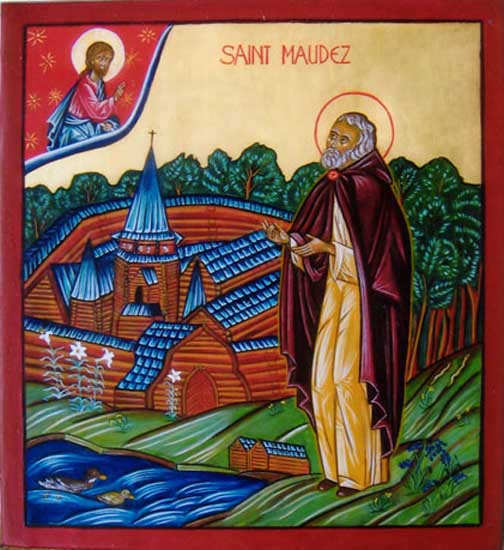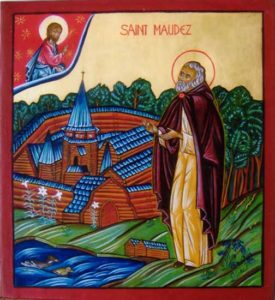St. Mawes, Maws, Maudetus, Maudez of Brittany celebrated on November 18th
3 min read
St. Mawes - source of icon http://www.christopherklitou.com/icon_18_nov_mawes_ascetic_near_falmouth_cornwall.htm
St. Mawes, Maws, Maudetus, Maudez of Brittany celebrated on November 18th

Biography
He is said to be from Ireland and moved from Ireland as an adult to live as a hermit. He first settled on the south coast of Cornwall near Falmouth where the village of St Mawes took his name.
Then, in the days of King Childbert I, Saint Mawes decided to return to
the land of his mother. On his way to Brittany, he visited Devon and
Cornwall, preaching outdoors and founding a town on the River Fal named after him.
Then he and his followers sailed for Brittany. Landing on an island
just off the coast of France near Leon, Ile Modez (Maudez), the saint
showed his skill by clearing it of vermin, setting fire to the dried
vegetation to do this. He also gained a reputation as a fine teacher.
Many churches in the region are dedicated to him–testifying to his
influence and missionary zeal.
One reason for Saint Mawe’s return to Brittany is said to have been to
escape yellow fever in Ireland. He subsequently became famed for his
ability to cure many kinds of sickness. After his death, the earth
under which he was buried was often taken away, mixed with water and
used as medicine.
just off the coast of France near Leon, Ile Modez (Maudez), the saint
showed his skill by clearing it of vermin, setting fire to the dried
vegetation to do this. He also gained a reputation as a fine teacher.
Many churches in the region are dedicated to him–testifying to his
influence and missionary zeal.
escape yellow fever in Ireland. He subsequently became famed for his
ability to cure many kinds of sickness. After his death, the earth
under which he was buried was often taken away, mixed with water and
used as medicine.
In Trégor he is said to have founded a monastery in the 5th century on the island of Maudez.
He settled there with two disciples, Saint Budoc and Saint Tudy (or Tugdual). He banished the snakes and that is why he is invoked by those who want to get rid of reptiles, insects, and worms. Traces of a beehive hut known as Forn Modez (Maudez’s oven) are visible on the island.
A commune in Côtes-d’Armor has the name Lanmodez (enclosure of Modez or Maudez) where the monastery of Maudez which he founded and where he died is located.
One day the last fire on the island was accidentally extinguished. Mawes sent a serving boy at low tide to
cross to the mainland and bring back a flame. As the boy set off back,
the tide came in. The waves rose higher and higher, threatening to
engulf the flame; but the boy stood on a rock,
prayed to Saint Mawes, and discovered the rock rising miraculously so
that it never sank beneath the sea. When the tide went out again, the
flame was successfully transported to Saint Maudez (Attwater,
Benedictines, Bentley, D’Arcy, Encyclopaedia, Farmer).
He is venerated at Falmouth and in Brittany (Roeder), where 60 churches
and chapels are named after him. The relics of Saint Mawes are
venerated at Quimper, Treguier, Lesneven, and Bourges (which claims his
body). He is invoked against headache, worms, and snake bites.
and chapels are named after him. The relics of Saint Mawes are
venerated at Quimper, Treguier, Lesneven, and Bourges (which claims his
body). He is invoked against headache, worms, and snake bites.
In the 9th century, his relics were taken to Bourges and to Saint-Mandé (Saint-Maudez), near Paris to escape from the Normans.
His Holy Well is preserved on Grove Hill and St Mawes Church is on nearby Church Hill . St Mawes Day continues to be celebrated on 18 November. When they returned to Brittany they were divided between nine churches.
Troparion of St Mawes tone 8
Despite thy royal birth thou didst embrace the monastic life in infancy,
O Father Mawes, boast of ascetics and banisher of snakes./ As we are
blessed to have thy precious relics with us to this day,/ pray O Saint,
that we may be worthy of Christ’s mercy and that our souls may be saved.







